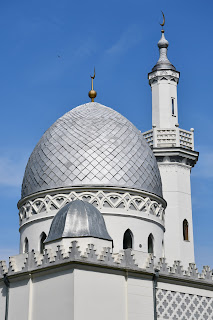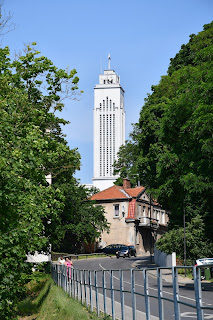The Baltics – Day 7: Kaunas and Trakai
On my last full day in Lithuania and the Baltic states, I saw my friend Diana, and together we made a trip to Lithuania’s second largest city Kaunas. The modern history of Kaunas is quite interesting, as it briefly became the country’s capital during the interwar period. During the Polish-Soviet War of 1919-1921, Vilnius frequently changed hands between the Poles and the Russians. In 1920, the Soviets awarded the captured city to Lithuania, but Polish President Józef Piłsudski secretly ordered a mutiny to annex Vilnius. Kaunas, which had been Lithuania’s provisional capital during the unrest after WWI, thus remained its capital for twenty years until its return to Lithuania in 1939 by the USSR – which proceeded to annex Lithuania in the following year.
Kaunas entered
a period of growth and artistic blossoming as Lithuania’s capital. Its Art Deco
buildings have been inscribed into the World Heritage List without detracting
from its already rich baroque and medieval inheritance. The most noteworthy
modernist sights in Kaunas include the townhouse at 58 Vytauto Street, the
townhouse at 19 Donelaičio Street, and Christ’s Resurrection Cathedral, which
stands on a hill above the city. I am sure the Art Deco Museum must be
interesting, but it can be visited by prior arrangement only.
In the old
town, the attractions of Kaunas include the Old Presidential Palace, the Town
Hall, and the delightfully round red brick castle. The Cathedral-Basilica of
Saint Peter and Saint Paul struck me as particularly ornate and colourful,
especially in comparison to the larger but duller cathedral in the capital. The
streets of the old town are lined with pastel-coloured houses and restaurants with
outdoor seating, giving Kaunas a welcoming atmosphere.
Getting to
Kaunas, I should mention, was a fun experience. When I tried to buy a ticket
from the ticket office for the nine o’clock train, I was told the tickets had
sold out and I would have to take the ten o’clock connection. After a moment’s
rumination, I decided to buy the ten o’clock ticket and take the nine o’clock
train anyway. I figured that if I got caught, I could simply claim my ignorance
as a tourist. The whole incident was all the more puzzling given quite a few
free seats remained by the time the train left Vilnius.
My English conversation
with Diana attracted a lot of attention from our fellow passengers, whose eyes
would occasionally dart towards us with surreptitious interest. We especially
captured the attention of a schoolboy sitting across from us, who initiated
conversation by flashing us a notepad with messily scribbled notes. The first
read “Hello, I am a local,” and the second continued with “Have you tried Šaltibarščiai?”
referring to cold borscht, a popular dish in Lithuania. After receiving amused
answers from us, the boy grew relaxed and began to converse with us freely.
From his forays into Japanese on Duolingo to his obsession with cheese, no
stone was left unturned by our new acquaintance.
Somewhere
in the first quarter of that conversation, the conductor came up and took issue
with my ticket. With Diana’s translation, I learned that she wanted me to pay
for another ticket – still a better outcome than receiving a fine or being
asked to leave the train. The situation, however, quickly resolved itself thanks
to an unexpected intervention. Whether out of pure kindness or in recognition
of our humouring her student, the teacher of the group volunteered an extra
ticket for me. I assume one of her students did not show up for the trip, and
the conductor did not seem to mind that I was clearly not in the same age
bracket as the ticket indicated.
Diana and I
split again in Kaunas, and she returned to Vilnius while I continued to the old
town. Once I finished my tour, I returned to Vilnius as well – this time with a
regional bus that only seemed to exist on Google Maps and not on the local
transportation app. The day’s travels were not over yet though: after waiting
for an hour, I took another bus to Trakai, a town that is home to an old and
iconic island castle. Unfortunately, the castle’s main tower was undergoing
renovations and the exhibitions were not all that interesting.




































Comments
Post a Comment